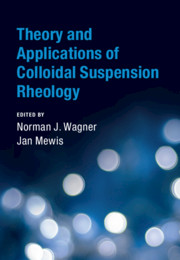Book contents
- Theory and Applications of Colloidal Suspension Rheology
- Cambridge Series in Chemical Engineering
- Theory and Applications of Colloidal Suspension Rheology
- Copyright page
- Dedication
- Contents
- Contributors
- Preface
- General List of Symbols
- Useful Physical Constants and Values
- 1 Introduction to Colloidal Suspension Rheology
- 2 Theory of Colloidal Suspension Structure, Dynamics, and Rheology
- 3 Methods of Colloidal Simulation
- 4 Microstructure under Flow
- 5 Rheology of Colloidal Glasses and Gels
- 6 Suspensions of Soft Colloidal Particles
- 7 Biocolloid Rheology
- 8 Hemorheology
- 9 Applications
- Index
- References
2 - Theory of Colloidal Suspension Structure, Dynamics, and Rheology
Published online by Cambridge University Press: 07 April 2021
- Theory and Applications of Colloidal Suspension Rheology
- Cambridge Series in Chemical Engineering
- Theory and Applications of Colloidal Suspension Rheology
- Copyright page
- Dedication
- Contents
- Contributors
- Preface
- General List of Symbols
- Useful Physical Constants and Values
- 1 Introduction to Colloidal Suspension Rheology
- 2 Theory of Colloidal Suspension Structure, Dynamics, and Rheology
- 3 Methods of Colloidal Simulation
- 4 Microstructure under Flow
- 5 Rheology of Colloidal Glasses and Gels
- 6 Suspensions of Soft Colloidal Particles
- 7 Biocolloid Rheology
- 8 Hemorheology
- 9 Applications
- Index
- References
Summary
Chapter 2 introduces the statistical physics description of the rheology of concentrated colloidal suspensions at low Reynolds number. While the solvent is a Newtonian fluid, the suspension exhibits viscoelasticity and non-Newtonian rheology. After explaining the hydrodynamic interactions between Brownian particles mediated by the intervening solvent flow, two theoretical methods for describing the suspension rheology are discussed. In the Langevin Equation method, stochastic particle trajectories are considered under the influence of direct and hydrodynamic interactions, and solvent-induced fluctuating forces. This method is fundamental to simulation schemes where the macroscopic suspension stress is calculated from time-averaging the microscopic stress over representative trajectories. The main focus is on the second so-called generalized Smoluchowski equation (GSmE) method invoking a many-particles diffusion-advection equation for the configurational probability density of Brownian particles in shear flow. Based on the GSmE, real-space and Fourier-space schemes are discussed for calculating rheological properties including the shear stress relaxation function and steady state and dynamic viscosities. Starting from exact Green-Kubo relations for the shear stress relaxation function, the linear mode coupling theory (MCT) and its non-linear extension, termed Integration Through Transients (ITT), are introduced as versatile Fourier-space schemes. They allow for studying the rheology of concentrated suspensions close to glass and gel transitions.
- Type
- Chapter
- Information
- Theory and Applications of Colloidal Suspension Rheology , pp. 44 - 119Publisher: Cambridge University PressPrint publication year: 2021
References
- 1
- Cited by



